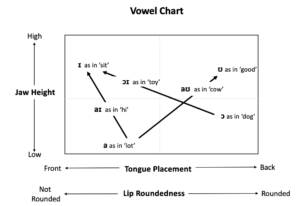Vowels of General American English
Vowels of General American English
Segmentals are one part of any accent learning program. Some will say that vowels of General American English are the most important piece of training.
GenAm Vowels
In General American English (GenAm), there is about 3 times the number of vowels compared to other languages. Because of this, regional dialects in the US are easily distinguished by vowel production. For example, the two words ‘pen’ and ‘pin, in the northern US, are pronounced differently, but in the southern US, they are pronounced the same. This feature actually has its own name: the pen/pin merger.
A good reference for vowels is the Standard Lexical Sets created by John C. Wells, in which he references two accents, General American English (GenAm) and Received Pronunciation (RP, a British dialect). Below is a chart for GenAm with the keyword, IPA symbol, and example words.
| Keyword | IPA Symbol | Example Words |
| Face | e | Name, Pay, Hey |
| Dress | ɛ | Egg, Neck, Rest |
| Fleece | i | Eat, Leap, Me |
| Goat | o | Road, Soak, Phone |
| Kit | ɪ | It, Rip, Did |
| Trap | æ | Flat, Glad, Nap |
| Strut | ʌ | Up, Just, Shut |
| Lot | a | Got, Lock, Swap |
| Thought | ɔ | Aw, Gone, All |
| Foot | ʊ | Bush, Put, Took |
| Goose | u | Mood, Juice, Move |
| Price | aɪ | Hi, Bye, My |
| Choice | ɔɪ | Toy, Boy, Joy |
| Mouth | aʊ | Ow, Cow, Loud |
Distinctive features
All vowels are voiced, while about only half of English consonants are, and are most influenced by 3 distinctive features.
- Jaw height
- Tongue placement
- Lip roundedness
Because of the number of vowels in GenAm, that means that there is more movement in the oral cavity to produce vowels, making vowels difficult for non-native speakers. The changes in jaw height, tongue position, and lip roundedness are very slight.
Vowel Chart
Below you will find a vowel chart. Since most people aren’t familiar with the International Phonetic Alphabet (IPA), orthographic words are matched with the symbol. However, you still need a basic understanding of how the words are produced with a native English accent.
The 3 distinctive vowel features can be seen in the vowel chart.
- Jaw Height: The vertical axis refers to the jaw height. Think of the jaw as having 3 planes or levels of opening.
a. Slightly open (high)
b. Moderately open (mid)
c. Widely open (low) - Tongue Placement: The horizontal axis refers to tongue placement: front, central (middle), and back.
- Lip Roundedness: The vowels in the left and middle of the chart are not rounded, with the exception of /i/ (‘e’ as in green), in which the lips are pulled back, or retracted. The vowels on the right of the chart are produced with a slight rounding of the lips.

Figure #2. Lim, K. (2021). Vowel Chart. Global Speech Therapy Blog. https://globalspeechtherapy.com/blog/
Because tongue movement is so slight, the easiest way to think about vowels is to think about jaw height.If your client has difficulty with vowel production, have them open and close the mouth or round and pull their lips back until they are able to produce the target sound. Changing jaw height automatically changes tongue position. If the mouth is widely open, the tongue has more room to move. If the mouth is only slightly open, there is limited room for tongue movement.
Produce a sustained ‘ah’ sound and open and close your jaw. Think about how the vowel sound changes with jaw height. Now produce a sustained ‘ah’ sound and protrude and retracted your lips. Think about how the vowel sound changes with lip-roundedness.
Diphthongs
A diphthong is formed by the blend of two vowels in a single syllable, in which the sound begins as one vowel and moves toward another. For example:
1. ‘ow’ as in ‘cow’
-
- ‘I’ as in ‘hi’
- ‘oy’ as in ‘toy’
Below is a vowel chart to show how vowels in GenAm are blended to form a diphthong.

Choosing Vowel Targets
When choosing vowels to target in accent modification, consider:
- What sounds do not occur in the client’s native language
- Frequency of occurrence in English
- Impact on intelligibility
Remember the articulation hierarchy mentioned in my post on Articulation Therapy (isolation/syllables, words, phrases, sentences, reading passages aloud, spontaneous). Initially, sounds should be introduced individually, in one position of the word (initial, medial, or final), and in 1 syllable words. As the client makes progress, you can quickly increase word length to 2-3 syllables, introduce other word positions, as well as target more than one sound in each trial. Keep in mind that some vowels are more difficult to produce in isolation, so starting with syllables or words is best. Also, some vowels do not occur in all positions of words. For example, /ɪ/ does not occur in final position of words.
Vowel Resources
There are not many resources out there for vowel stimuli. For stimuli for each vowel sound in General American English, click here. Each target vowel sound contains stimuli for the context levels:
- Words- single syllable (105 words)
- Phrases- repeated occurrence (45 phrases)
- Phrases- single occurrence (105 phrases)
- Sentences- repeated occurrence (40 sentences)
- Sentences- single occurrence (40 sentences)
Vowels included:
/e/ as in ‘face’
/aʊ/ as in ‘mouth’
/ɛ/ as in ‘dress’
/i/ as in ‘fleece’
/o/ as in ‘goat’
/ɪ/ as in ‘kit’
/æ/ as in ‘trap’
/ʌ/ as in ‘strut’
/a/ as in ‘lot’
/ɔ/ as in ‘thought’
/ʊ/ as in ‘foot’
/u/ as in ‘goose’
/ɔɪ/ as in ‘choice’
/aɪ/ as in ‘price’
Vocalic /ɹ/ as in ‘nurse’
For information on General American English consonants, read my post!

2 Comments